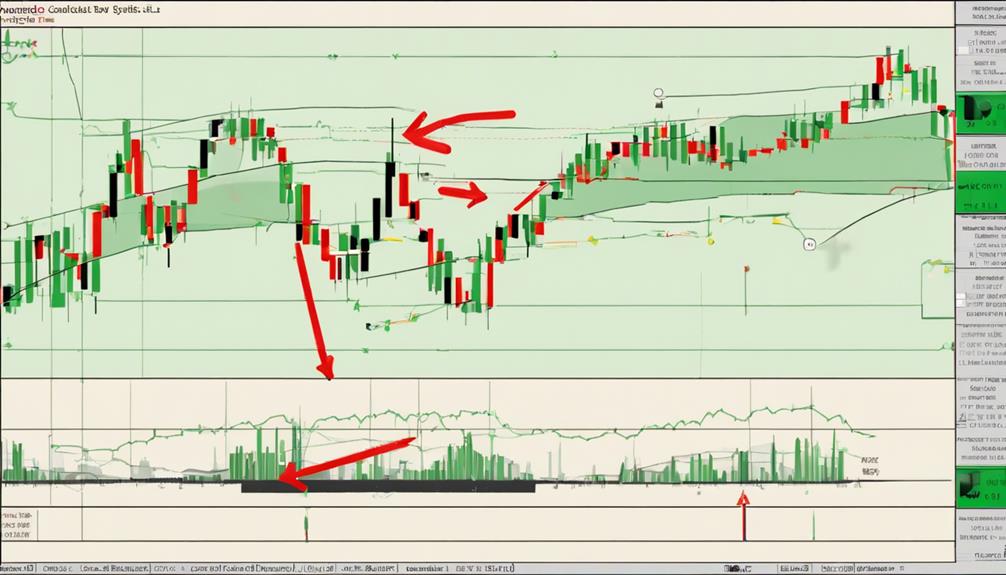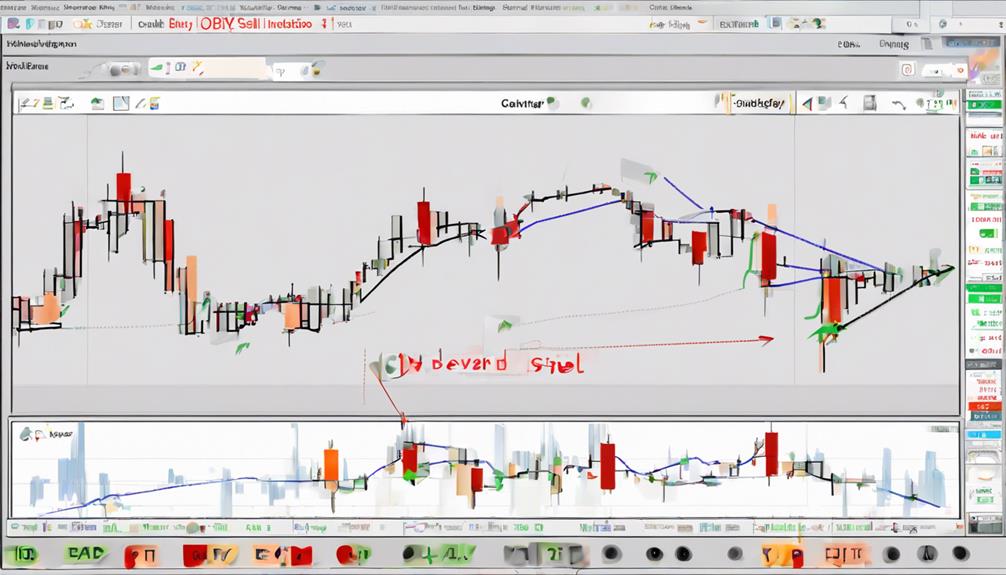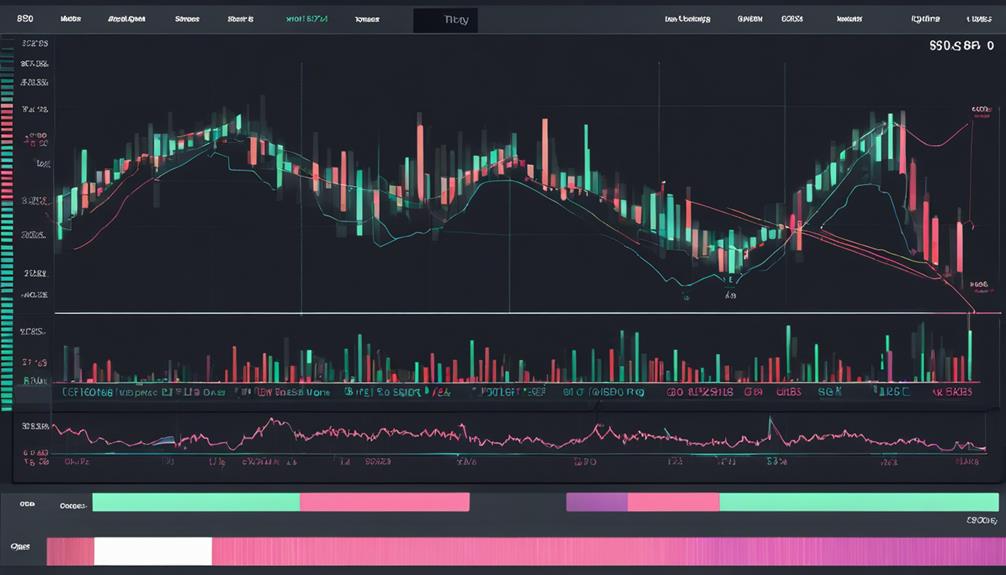The practical application of the On-Balance Volume (OBV) indicator in trading strategies offers a nuanced approach to interpreting market dynamics. Understanding how this indicator functions as a leading indicator can provide traders with valuable insights into potential price movements.
By honing in on the directional shifts of OBV, traders can anticipate trends, validate their strength, and identify opportune moments for trading. However, the true effectiveness of the OBV indicator lies in its integration with complementary tools like moving averages, allowing traders to navigate market complexities with more precision.
This strategic integration opens up a realm of possibilities for traders seeking a comprehensive understanding of market trends and dynamics.
Understanding OBV Indicator Basics
The foundation of comprehending the OBV indicator lies in grasping its fundamental principles and operational mechanics. OBV, or On-Balance Volume, is a technical analysis tool that uses volume flow to provide insight into price movements.
By tracking the cumulative volume based on whether the price closes higher or lower than the previous day, OBV offers traders a way to assess the balance between buying and selling pressure. This indicator helps identify trends and potential trend reversals by analyzing the relationship between volume and price changes.
Traders utilize OBV to confirm the strength of a trend, spot potential breakouts, and filter out false signals that may arise from price fluctuations. Developed by Joseph Granville in the 1960s, OBV has since become a popular tool for market analysts seeking to make informed trading decisions based on volume analysis.
Understanding the basics of OBV is crucial for traders looking to enhance their technical analysis skills and improve their trading strategies.
Interpreting OBV Signals Effectively

Building on the foundational understanding of OBV indicator basics, effectively interpreting OBV signals is essential for traders seeking to make informed decisions based on volume analysis.
When interpreting OBV signals, traders should focus on the direction of OBV rather than its specific value to accurately gauge buying and selling pressure in the market. Higher peaks and troughs in both price and OBV typically indicate a potential upward trend, while lower peaks and troughs suggest a possible downward trend.
During a trading range, rising OBV signals accumulation and a potential upward breakout, whereas falling OBV indicates distribution and a potential downward breakout. It is crucial to pay attention to price movements in relation to OBV to identify potential stalls in trends, such as negative divergence where price rises but OBV does not follow suit.
Implementing OBV in Trading Strategies

Utilizing the OBV indicator in trading strategies serves as a valuable tool for confirming trend strength and pinpointing potential reversals in the market. When implementing OBV in trading strategies, consider the following:
- Use OBV to analyze volume flow and confirm trend strength.
- Utilize OBV for breakout signals to filter out false breakouts and identify opportunities for trend continuation.
- Apply OBV in Forex trading to predict potential reversals accurately, confirm trends, and set appropriate stop-loss and take-profit levels.
- Incorporate OBV in intraday trading on M5 to M30 charts, focusing on unusual divergences for strategic entries and exits.
To enhance trading strategies further, consider combining OBV with moving averages. This combination can help establish entry conditions, manage risk effectively, and improve overall trade decision-making processes. By integrating these elements, traders can leverage the OBV indicator to make informed decisions and improve their trading outcomes.
Overcoming OBV Indicator Challenges

To effectively navigate and optimize the utilization of the OBV indicator in trading strategies, traders must strategically address and overcome the inherent challenges associated with its implementation. Volume is a leading indicator, making OBV a valuable tool for assessing the strength of market trends and potential trend reversals.
However, OBV is not without its challenges. Sudden volume spikes can lead to false signals, impacting the reliability of OBV predictions. One way to address this is by combining OBV with lagging indicators like moving averages to confirm a breakout and improve its accuracy. Additionally, understanding the position of the current volume in relation to market trends and the involvement of smart money can provide valuable insights when interpreting OBV signals.
Enhancing Trading Performance With OBV

Enhancing trading performance through the strategic application of the On-Balance Volume (OBV) indicator offers traders a valuable tool to confirm trend strength and identify potential market reversals. By incorporating OBV into trading strategies, traders can enhance their decision-making process and improve overall performance.
Here are key ways to leverage OBV effectively:
- Utilize OBV for breakout signals to filter out false breakouts and make informed trading decisions.
- Implement OBV in Forex trading to predict reversals, set stop loss levels, and determine take profit levels.
- Intraday traders can leverage OBV on M5 to M30 charts for spotting unusual divergences and making timely trades.
- Combine OBV with moving averages for effective entry conditions and risk management strategies in trading.
How Can I Use the OBV Indicator in a Practical and Effective Manner?
When it comes to implementing OBV indicator benefits, it’s important to use this tool in a practical and effective manner. By tracking volume and price movements, the OBV indicator can help identify momentum shifts and potential trend reversals, allowing traders to make informed decisions.
Frequently Asked Questions
What Is the OBV Indicator Strategy?
The OBV indicator strategy involves tracking volume flow to confirm trends, spot reversals, and gauge market sentiment. Traders apply OBV to validate trends, anticipate reversals, and enhance trading decisions by combining it with complementary indicators.
What Is the Best Time Frame for OBV Indicator?
The best time frame for the OBV indicator is typically on medium to longer-term charts, such as daily or weekly time frames. Shorter time frames like intraday charts may introduce noise and fluctuations, affecting analysis accuracy.
How Reliable Is the OBV Indicator?
The On-Balance Volume (OBV) indicator, likened to a seasoned navigator guiding through the market's currents, is reliable in trending markets with moderate liquidity. Its early signals and simple formula provide accuracy in predicting price movements.
What Is the OBV Breakout Strategy?
The OBV breakout strategy involves utilizing the On-Balance Volume (OBV) indicator to confirm price breakouts. Traders monitor OBV movement aligning with price direction to validate breakouts. This strategy enhances trend analysis accuracy for informed trading decisions.
Conclusion
In conclusion, the practical approach to the OBV indicator involves understanding its function as a leading indicator to predict price movements accurately.
By combining OBV with lagging indicators, traders can validate breakouts and minimize false signals, leading to more reliable analysis of market dynamics.
This strategic use of OBV can enhance trading performance and help traders make well-informed decisions in the ever-changing financial markets, like a skilled navigator charting a course through turbulent waters.
